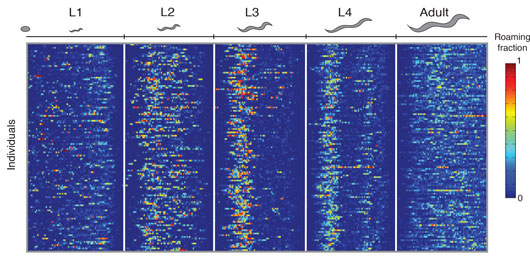Animals generate complex patterns of behavior across life that can be modified over days, months, or years. Across these long timescales, individuals within the same population may show stereotyped behaviors, but also unique behaviors that distinguish them from each other, a property called individuality. While individuality in behavior is widespread across species, including humans, the underlying mechanisms that generate individual-to-individual behavioral variation remain largely unknown.

Figure: Roaming and dwelling behavior of 125 wild-type (N2) individuals imaged for ~50 hours across their full developmental trajectory.
To examine the contributions of developmental programs and individual variation to behavior we developed a new multi-camera imaging system to monitor the behavior of multiple individual C. elegans animals across development, from egg hatching to adulthood, spanning a full generation. In this imaging setup, the spontaneous foraging behaviors of single animals were continuously monitored at high spatiotemporal resolution for days, under the same controlled environmental conditions. By using this imaging system we discovered that while C. elegans animals have reproducible patterns of long-term behaviors, individuals within isogenic populations show consistent behavioral biases that persist across development and distinguish them from one another. This discovery has enabled us to establish a rigorous model for investigating the underlying mechanisms that shape behavioral individuality. Using this new framework, we identified specific signaling pathways that regulate stage-specific behaviors, and can either increase or decrease the degree of non-genetic individuality across the population. In particular, we found that a deficiency in the production of serotonin or the loss of a single serotonin receptor leads to a dramatic decrease in individuality.
Overall, this study opens a new window for dissecting mechanisms that generate and shape behavioral individuality, as well as for understanding the organization and regulation of behavior across developmental time-scales.
Reference
Neuromodulatory control of long-term behavioral patterns and individuality across development. Stern, S., Kirst, C., Bargmann, C. I. Cell 171, 1649-1662 (2017).


































